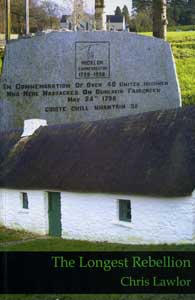29 November 2007 Edition
1798 in West Wicklow brought alive

The-Longest-Rebellion
BOOK REVIEW
The Longest Rebellion: The Dunlavin massacre, Michael Dwyer and West Wicklow 1798-1803
By Chris Lawlor
Published by Small World Media
Price €15
Available at the Sinn Féin bookshop, 58 Parnell Square, Dublin 1
www.sinnfeinbookshop.com
Reviewed by Aengus Ó Snodaigh
The Longest Rebellion: The Dunlavin massacre, Michael Dwyer and West Wicklow 1798-1803
By Chris Lawlor
Published by Small World Media
Price €15
Available at the Sinn Féin bookshop, 58 Parnell Square, Dublin 1
www.sinnfeinbookshop.com
Reviewed by Aengus Ó Snodaigh
Through dissecting local sources, Chris Lawlor in his new book sets the scene for the 1798 Revolution in West Wicklow until the failure of the Robert Emmet Rising 1803. Such a book is vital for every county, town, village or townland, where local history is made a living history, where the facts and details, overlooked or passed over as not being important, are given their proper import. What may seem not important to an academic from the outside not knowing the local nuances, can often be the key detail around which events revolved.
Reprinted with the historical account are the Dunlavin Green ballads, lists of the executed men [there is a dispute as to how many], six ballads on Michael Dwyer’s exploits, court martial records, letters from Kilmainham Jail and other material.
One criticism is that for those not from the area, the map should have been at the front to save flicking to the middle whenever another local place is mentioned. Having said that, Chris succeeded in giving a vivid picture of Dunlavin, its hinterland and natural urban centres.
This book should be read before reading the other local or localised history such as Ruan Ó Donnell’s detailed accounts of Wicklow’s role in 1798 and the aftermath or Kieran Sheedy’s accounts of Michael Dwyer’s transportation to Australia and after.
Chris sets out, and succeeds, in giving the background to the summary execution of untried prisoners on Dunlavin Green and the hanging of others held in the village’s Market House, that same day, 24 May 1798.
Using a wealth of local information in the form of ballads, letters to Dublin Castle, informers memos to their handlers and personal diaries he shows how the area was a simmering pot of ideologies, grievances, perceptions, emotions and outright sectarianism as the landlords began to sense the growth of republicanism in their area and the threat to the status quo which the United Irishmen were to the British empire. He also shows how some of the landed gentry took to their ‘military’ role as yeomen, militiamen or other with gusto, it “was probably a bit like playing soldiers” to some. Except it was playing with real lives, and the cost to the ordinary people was huge over the five years of rebellion and resistance in West Wicklow.
Various strands of contemporary life are pulled together, through use of local archival material to set events in the context of local and national history.
The book shows how local popular memory is authenticated by the author’s forensic dissecting of the local sources and he shows that in fact the massacre proved to be an effective deterrent to a general uprising of the populace in West Wicklow.
But, Michael Dwyer’s campaign of resistance in the area from 1798 until 1803 served as a “symbol of hope at a time and a place of oppression. As he continued to evade capture, that symbol became brighter and the hope, instead of being dashed, grew in the breasts of an admiring public”.
Hope faded with the collapse of Emmet’s plans in 1803, and with it the key central role Michael Dwyer and his group of United Irishmen were to play. The story of Dwyer’s campaign and its end is a blockbuster film waiting to be made, as are much of the other events of the era, where ordinary men and women were catapulted into extraordinary times, where many excelled and carried out daring deeds without question or favour.


